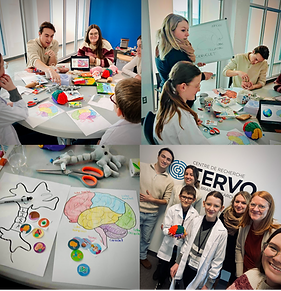
RESEARCH
Understanding simple and complex decision-making

Networks
Values
Consequences
Vulnerabilities
Everyday life requires decisions that range from trivial to consequential. Low-stakes choices often rely on heuristics, while high-stakes contexts engage large-scale brain networks, in particular the salience network, central executive network, and default mode network, to balance reward, risk, and uncertainty. At the highest level, these processes extend to moral decision-making, where choices are guided not only by outcomes but also by values and principles.
From a non-pathological perspective, individual differences in personality traits such as impulsivity or tolerance to uncertainty influence how these networks are recruited. This is especially evident in populations regularly exposed to high-stakes contexts, such as emergency physicians, firefighters, military personnel, or political leaders, whose decisions combine rapid judgment with sustained cognitive control.
In psychiatry, similar mechanisms can become dysregulated: heightened salience processing in anxiety or weakened executive control in addiction can bias both trivial and consequential choices. Neurological patients further illustrate how lesions or degeneration disrupt network dynamics, offering direct evidence of the brain systems that sustain decision-making.
Exploring the plasticity of decision-making

Adaptation
Practice
Technology
Ethics
Decision-making is not fixed. The brain’s networks adapt across life, influenced by experiences, habits, and training. Neuroplasticity allows both low- and high-stakes choices to be reshaped by repeated practice, environmental changes, or major life events.
Research shows that everyday activities such as playing video games or practicing meditation can tune attention, emotion regulation, and cognitive control, thereby modifying the networks that guide decisions. These non-invasive forms of training reveal how lifestyle and practice can strengthen or recalibrate the brain’s decision systems.
At the same time, advances in neurotechnology open new possibilities. Brain stimulation techniques, such as non-invasive stimulation or deep brain stimulation, can directly modulate neural circuits involved in simple decision-making and moral processes. These approaches highlight both the potential to enhance adaptive choices and the ethical responsibility to ensure safe and responsible use of neuroplasticity-based interventions.
Modeling
decision-making across
mind and brain

Mechanisms
Prediction
Translation
To understand how decisions work, including their moral dimension, modeling is essential. Formalizing decision processes helps clarify the mechanisms at play, anticipate outcomes, and design interventions that are both effective and safe.
Our approach combines psychological theories of choice with computational neuroscience. We apply methods such as Bayesian inference, predictive coding, and hidden Markov models to capture how decisions emerge under uncertainty and how they can be biased or improved. By integrating behavioral data, neural dynamics, and large-scale brain networks, we build models that link mechanisms to outcomes.
This modeling framework is inherently multidisciplinary and translational. It allows us to link laboratory findings with clinical challenges, and to move from fundamental understanding to applications that support adaptive decision-making while avoiding unintended consequences.
Techniques
We use advanced functional and structural neuroimaging techniques to investigate how the brain supports decision-making. Through these approaches, we study both everyday choices and complex moral judgments.
NOMAD FOR KIDS
Workshops for curious minds
At NoMaD, our workshops invite children and adolescents to explore how the brain learns, feels, and adapts. Through playful, hands-on activities, participants discover basic neuroscience while developing metacognitive skills, the ability to think about their own thinking.
Each session promotes equity, diversity, and inclusion by valuing every perspective and encouraging collaborative discovery. Rooted in neuroeducation, the program aims to foster curiosity, empathy, and positive development.
Join us in building a generation that understands both the science of the brain and the importance of caring for it and for one another.

Our philosophy

1
Understanding how the brain shapes human action
We investigate how the brain and mind navigate decisions, from low-stake everyday actions to high-stake moral judgments that define who we are.
2
Connecting science
and society
Our research bridges psychology, neuroscience, and ethics to reveal how context, emotion, and values shape human behavior and how this knowledge can promote fairness, empathy, and resilience.
3
Translating insight
into change
We study how learning and neuroplasticity allow the brain to adapt and how targeted interventions can help people decide and act better.


